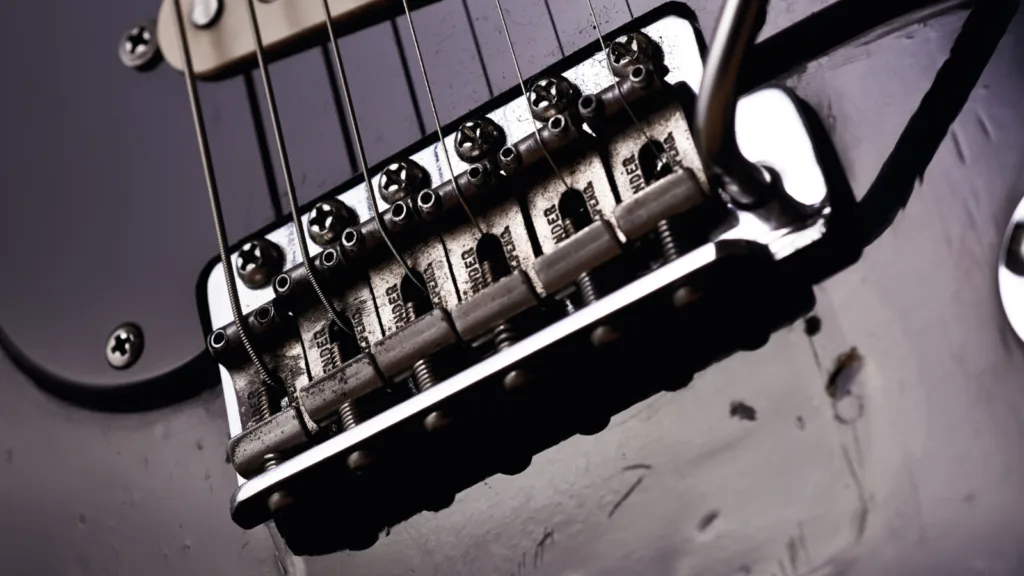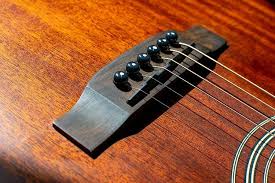Have you ever wondered what those small parts on your guitar are called? I’m talking about the little piece that holds the strings in place near the bottom of your instrument. That, my friends, is called a guitar bridge. And if you’re new to playing or just curious about how your guitar works, this article is for you.
In this article, we’ll dive into everything you need to know about a guitar bridge – from its purpose and components to how it affects your playing and sound. Whether you’re an aspiring musician or simply want to expand your knowledge of guitars, keep reading as we unravel the mysteries of this important but often overlooked part of our beloved instruments. So let’s get started and discover all there is to know about a guitar bridge!
So, What is a guitar bridge?
A guitar bridge is a critical component of an acoustic or electric guitar that supports the strings and transfers their vibrations to the body of the instrument. It is typically located on the lower part of the guitar’s body, just below where the strings are attached to the tuning pegs. The main function of a guitar bridge is to hold each string at a specific tension and height, allowing for precise tuning and intonation. There are various types of bridges, including fixed bridges, tremolo bridges, and floating bridges, each with its own unique design and purpose. A well-made bridge can greatly impact the sound quality and playability of a guitar, making it an essential element for any musician looking to achieve their desired tone.
Understanding the Function of a Guitar Bridge
The guitar bridge plays a crucial role in the instrument’s overall sound and playability. Positioned on the body of the guitar, this component is where the strings anchor to transfer their vibrations to the wooden structure. This connection not only holds everything together but also helps shape how a guitar resonates. The material used for bridges can vary widely—from wood to metal—each affecting tone differently. For instance, a wooden bridge often produces warmer sounds, while metal bridges can offer brighter tones with increased sustain.
Additionally, there are different types of bridges depending on whether you have an acoustic or electric guitar. Acoustic guitars typically feature fixed bridges that provide stability and strength, ensuring each strum or pluck delivers clear notes. Electric guitars may use tremolo bridges that allow players to bend notes dramatically by altering string tension. Players can manipulate their sound through these variations, exploring musical expression unique to their style. Understanding how each type influences tone and playability not only enhances performance but also deepens appreciation for this remarkable instrument and its capabilities in creating beautiful music.
Read also: 3 guitar rack
Exploring Different Types of Guitar Bridges
When it comes to guitars, the bridge is a vital component that helps transmit vibrations from the strings to the body of the instrument. There are different types of guitar bridges, each offering unique characteristics and benefits. For instance, fixed bridges provide stability and tuning consistency since they don’t move at all during playing. This makes them great for musicians who prioritize perfect pitch over intricate techniques like string bending. In contrast, tremolo bridges, often referred to as whammy bars, allow players to create expressive pitches by bending notes downward or upward effortlessly. The versatility of these bridges can produce a wide range of sounds but may require more frequent tuning adjustments.
Another type worth mentioning is the floating bridge which allows for smooth movement while still maintaining some level of tension on the strings. Players love these for their ability to achieve dramatic effects in sound without compromising playability too much. Additionally, there are also variations like hardtail bridges, which combine features from both fixed and tremolo designs that appeal particularly to rock guitarists seeking robust sustain with minor pitch alterations available through limited whammy effects.
Each bridge type serves its purpose depending on musical style and preferences; understanding them enhances your overall playing experience significantly!
How to Adjust and Maintain Your Guitar Bridge
When it comes to playing the guitar, the bridge is like a magical doorway that connects your strings to the body of the instrument. It plays a crucial role in how your guitar sounds and feels. To keep everything harmonious, you should learn how to adjust and maintain this tiny yet mighty component. First, check for any signs of wear or damage on your bridge; small cracks or loose parts can affect sound quality. If you notice something amiss, tightening screws gently with appropriate tools may help secure it back in place. Regularly cleaning your bridge by wiping it down with a soft cloth helps remove dust and grime that could dampen its tone.
Next, understanding string height is vital for playability. If you’re having trouble fretting notes smoothly, adjusting the saddle height might be necessary. You can do this by carefully filing down or raising saddles according to preference—just make sure not to overdo it! Additionally, monitoring humidity levels around your instrument is essential since changes can cause wood components to swell or shrink over time. Keeping an eye on these factors will ensure that your guitar’s voice remains sweet and vibrant for years to come!

The Impact of the Guitar Bridge on Sound Quality
The guitar bridge is more than just a sturdy piece that holds the strings in place; it plays a crucial role in shaping the instrument’s overall sound. When you think about it, every strum and pluck travels through this vital component. The materials used for a bridge can significantly affect tone quality. For instance, wooden bridges often produce warmer sounds with rich overtones, while composite or metal bridges might bring out brighter tones that resonate differently. Additionally, the design of the bridge—whether it’s fixed or floating—can impact how vibrations are transferred to the body of the guitar, ultimately influencing resonance and sustain.
Furthermore, the setup of the bridge also matters greatly. A well-adjusted bridge ensures proper string height and alignment, which helps avoid buzzing notes and allows each string to vibrate freely. This precise arrangement affects not only playability but also how harmonics are produced during performance. Musicians often experiment with different types of bridges to find one that complements their playing style best. In essence, whether you’re strumming chords or fingerpicking intricate melodies,
understanding your guitar’s bridge can unlock a world of tonal possibilities that elevate your music-making experience.
- Material choice influences warmth vs brightness.
- Design impacts vibration transfer.
- A well-set-up bridge enhances playability.
You may also like: yamaha c40 classic guitar
Conclusion: The Integral Role of a Guitar Bridge in Music Creation
The guitar bridge is not just a simple component; it serves as the heart of sound production. This little piece, often made from wood or synthetic materials, connects the strings to the body of the guitar. It helps transfer vibrations from the strings through the body, creating rich tones that resonate with listeners. A well-crafted bridge can make all the difference in how a guitar sounds, whether it’s bright and sharp or warm and mellow. The positioning and construction of this element influence everything from sustain to intonation, affecting how notes are played across different frets.
Moreover, there are various types of bridges designed for specific styles of music. For example, fixed bridges offer stability and ease while playing chords or solos without unwanted string movement. In contrast, tremolo bridges, like those found on Fender Stratocasters, allow musicians to create unique pitch effects that add whimsy to their songs. When you strum a chord or pluck a solo note, remember: your fingers may touch the strings directly but it’s really the bridge working behind-the-scenes—shaping your melody into something beautifully harmonious.
So next time you hear an enchanting tune wafting through the air, think about that unsung hero nestled beneath your fingertips!

